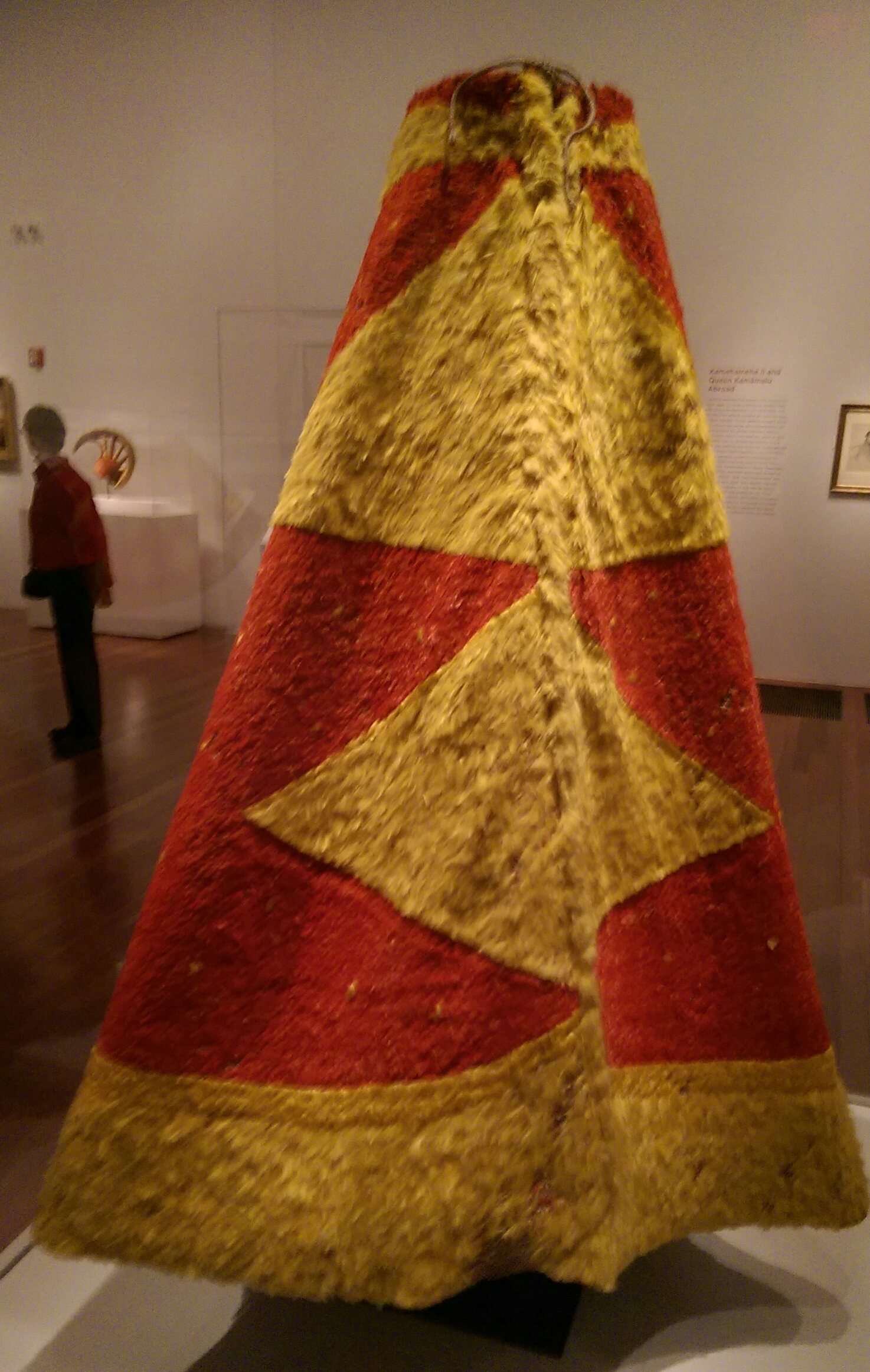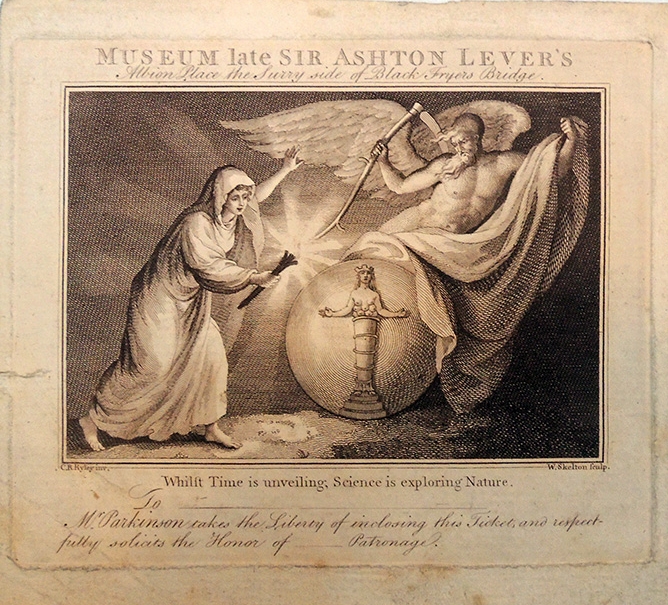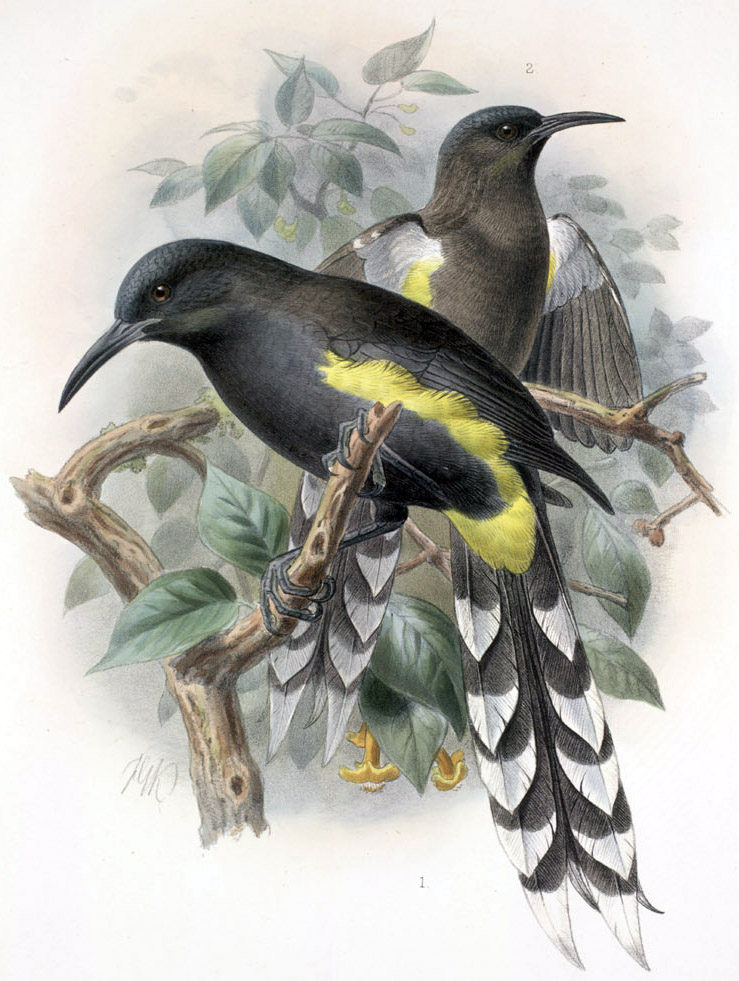|
Mahiole
Hawaiian feather helmets, known as ''mahiole'' in the Hawaiian language, were worn with feather cloaks (ʻahu ʻula). These were symbols of the highest rank reserved for the men of the ''alii'', the chiefly class of Hawaii. There are examples of this traditional headgear in museums around the world. At least sixteen of these helmets were collected during the voyages of Captain Cook.To attempt some new discoveries in that vast unknown tract Adrienne Kaeppler, Smithsonian Museum of Natural History, Washington DC Cook’s Pacific Encounters symposium, National Museum of Australia, 28 July 2006 These helmets are made from a woven frame structure decorated with bird feathers an ... [...More Info...] [...Related Items...] OR: [Wikipedia] [Google] [Baidu] |
ʻAhu ʻula
The ''ʻAhu ʻula'' (feather cloak in the Hawaiian language), and the ''mahiole'' (feather helmet) were symbols of the highest rank of the chiefly ''aliʻi'' class of ancient Hawaii. The feathered cloaks and capes provided physical protection, and were believed to provide spiritual protection for their wearers. There are over 160 examples of this traditional clothing in museums around the world. At least six of these cloaks were collected during the voyages of Captain Cook. These cloaks are made from a woven netting decorated with bird feathers and are examples of fine featherwork techniques. One of these cloaks was included in a painting of Cook's death by Johann Zoffany. Construction The cloaks were constructed using a woven netting decorated with feathers obtained from local birds. The plant used to make the netting is '' Touchardia latifolia'', a member of the nettle family. The coloring was achieved using different types of feathers. Black and yellow came from four speci ... [...More Info...] [...Related Items...] OR: [Wikipedia] [Google] [Baidu] |
Kalaniʻōpuʻu
Kalaniōpuu-a-Kaiamamao (c. 1729 – April 1782) was the aliʻi nui (supreme monarch) of the island of Hawaiʻi. He was called ''Terreeoboo, King of Owhyhee'' by James Cook and other Europeans. His name has also been written as Kaleiopuu. Biography Kalaniʻōpuʻu was the son of Kalaninuiamamao (k) and his wife Kamākaʻimoku (w), a high ranking aliʻi wahine (female of hereditary nobility) who was also the mother of Keōua (k) with another husband named Kalanikeʻeaumoku (k). This made her the grandmother of Kamehameha I. During his reign, Alapainui had kept the two young princes, Kalaniʻōpuʻu and Keōua, close to him out of either kindness or politics. Kalaniōpuu-a-Kaiamamao was the king of the island during the times Captain James Cook came to Hawaiʻi and went aboard his ship on November 26, 1778. After Cook anchored at Kealakekua Bay in January 1779, Kalaniōpuu-a-Kaiamamao paid a ceremonial visit on January 26, 1779 and exchanged gifts including a ʻahuʻula (f ... [...More Info...] [...Related Items...] OR: [Wikipedia] [Google] [Baidu] |
Freycinetia Arborea
''Freycinetia arborea'', ''Ieie'', is a densely branched, brittle, Woody plant, woody Vine#Climbing plants, climber in the family Pandanaceae, Endemism, endemic to the Pacific Islands. ''Ieie'' is found in Tropical and subtropical moist broadleaf forests, moist forest on the Hawaiian tropical rainforests, Hawaiian, Marquesas Islands, Marquesas, Austral Islands, Austral, Society Islands, Society, and Cook Islands. It grows into the Canopy (forest), forest canopy, attaching itself to a host tree using aerial roots. It may also grow as a sprawling tangle on the forest floor. The shiny green Leaf, leaves have pointed ends and are spiny on the lower side of the midrib and along the edges. Leaves measure long and wide, and are spirally arranged around the ends of branches. Flowers form on spike-like inflorescences at the end of branches, and are either Stamen, staminate or Gynoecium, pistillate. Staminate spikes are yellowish-white and up to in length. Pistillate spikes are but e ... [...More Info...] [...Related Items...] OR: [Wikipedia] [Google] [Baidu] |
The Death Of Captain James Cook (Zoffany)
''The Death of Captain James Cook, 14 February 1779'' is a painting by Johann Zoffany. The painting records the loss of the British explorer Captain James Cook. The painting was made in around 1794 or 1795, some years after the death of Cook in 1779. Other paintings of the death of Cook were painted earlier. The Mahiole (Feathered Helmet) that was included in the painting of Cook's death by Zoffany is said to be the helmet given to Cook when he first landed in Hawaii. Painting's construction The painting is unfinished. Zoffany is thought to have based the painting on another made of Cook's death by John Webber who was the official artist on Cook's third voyage. Zoffany had been invited at one time to be an artist on one of Cook's voyages and it is thought that he may have previously painted Cook. Webber had not witnessed the death of Cook, but he would have known many of the people involved. He would have known the English sailors but he would also have seen many of the natives. W ... [...More Info...] [...Related Items...] OR: [Wikipedia] [Google] [Baidu] |
ʻApapane
The apapane (''Himatione sanguinea,'' pronounced /ˌ ɑ pɑˈpɑ neɪ/, ''ah-pah-PAH-ney'') is a small, crimson species of Hawaiian honeycreeper endemic to the Hawaiian Islands. They are the most abundant and widely distributed honeycreeper and are found on the islands of Hawaii, Maui, Lānai, Kauai, Molokai and Oahu. Apapane commonly forage in the canopies of ''ōhia'' ('' Metrosideros polymorpha'') trees, drinking nectar from the flowers and serving as important pollinators. Hawaiians primarily used red feathers from ʻiʻiwi, but also some from ʻapapane, to adorn the ''ahuula'' ( capes), '' mahiole'' (helmets), and '' nā lei hulu'' (feather leis) of '' alii'' (Hawaiian nobility). Description Apapane are small at when fully grown. They are sexually dimorphic in size: male apapane have a mass of , while females average . Adult apapane are overall bright crimson, with distinct white undertail-coverts and lower abdomen feathers. They have black primaries and retr ... [...More Info...] [...Related Items...] OR: [Wikipedia] [Google] [Baidu] |
Featherwork
Featherwork is the working of feathers into a work of art or cultural artifact. This was especially elaborate among the peoples of Oceania and the Americas, such as the Incas and Aztecs. Feathered cloaks and headdresses include the '' ʻahuʻula'' capes and '' mahiole'' helmets were worn by Hawaiian royalty; many are now on display at the Bishop Museum, and other museums across the world. Kāhili are a type of feathered standard, another symbol of royalty. The introduction of foreign species, overhunting, and environment changes drove birds with desirable feathers, such as the ‘ō‘ō and mamo, to extinction, although the ʻiʻiwi managed to survive despite its popularity. Mexican feather work was a Pre-Columbian art form which was continued after the Conquest of the Aztec Empire, originally organized by the Spanish missionaries into a luxury export trade, sending objects back to Europe. Immediately after the conquest existing objects such as Montezuma's headdress, no ... [...More Info...] [...Related Items...] OR: [Wikipedia] [Google] [Baidu] |
British Museum
The British Museum is a public museum dedicated to human history, art and culture located in the Bloomsbury area of London. Its permanent collection of eight million works is among the largest and most comprehensive in existence. It documents the story of human culture from its beginnings to the present.Among the national museums in London, sculpture and decorative and applied art are in the Victoria and Albert Museum; the British Museum houses earlier art, non-Western art, prints and drawings. The National Gallery holds the national collection of Western European art to about 1900, while art of the 20th century on is at Tate Modern. Tate Britain holds British Art from 1500 onwards. Books, manuscripts and many works on paper are in the British Library. There are significant overlaps between the coverage of the various collections. The British Museum was the first public national museum to cover all fields of knowledge. The museum was established in 1753, largely ... [...More Info...] [...Related Items...] OR: [Wikipedia] [Google] [Baidu] |
James Parkinson (1730–1813)
James Parkinson (baptised 28 February 1730, St Mary's Church, Shrewsbury – 25 February 1813) was an English land agent and the proprietor of the Leverian Museum which he won in a lottery. He then moved the Leverian collection to a museum at the Blackfriars Rotunda which was sometimes referred to as "Parkinson's Museum". He has sometimes been confused with the surgeon James Parkinson. Life Parkinson was the son of James Parkinson and his wife, Jane Birch who had moved from Ireland to Shrewsbury in 1723. His first training was as a law stationer, but he then became a land agent and accountant. In 1769 he helped in the settlement of Sir Thomas Robinson's tangled estates at Rokeby, Yorkshire. This success made his reputation. He later became involved in the Ranelagh Gardens. Parkinson's wife Sarah (married around 1775) had bought two tickets at a guinea each of the lottery for the disposal of the Holophusicon collection of Sir Ashton Lever sometime in 1784. On 23 March 1786, the d ... [...More Info...] [...Related Items...] OR: [Wikipedia] [Google] [Baidu] |
Leverian Museum
The Leverian collection was a natural history and ethnographic collection assembled by Ashton Lever. It was noted for the content it acquired from the voyages of Captain James Cook. For three decades it was displayed in London, being broken up by auction in 1806. The first public location of the collection was the Holophusikon, also known as the Leverian Museum, at Leicester House, on Leicester Square, from 1775 to 1786. After it passed from Lever's ownership, it was displayed for nearly twenty years more at the purpose-built Blackfriars Rotunda just across the Thames, sometimes called Parkinson's Museum for its subsequent owner, James Parkinson (c. 1730-1813). At Alkrington Lever collected fossils, shells, and animals (birds, insects, reptiles, fish, monkeys) for many years, accumulating a large collection at his home at Alkrington, near Manchester. He was swamped with visitors, whom he allowed to view his collection for free, so much so that he had to insist that visitors ... [...More Info...] [...Related Items...] OR: [Wikipedia] [Google] [Baidu] |
Moho (genus)
__NOTOC__ ''Moho'' is a genus of extinct birds in the Hawaiian bird family, Mohoidae, that were endemic to the Hawaiian Islands. Members of the genus are known as ''ōō'' in the Hawaiian language. Their plumage was generally striking glossy black; some species had yellowish axillary tufts and other black outer feathers. Most of these species became extinct by habitat loss, the introduction of mammalian predators (like rats, pigs, and mongooses), and by extensive hunting (their plumage was used for the creation of precious ''aahu alii'' (robes) and ''ahu ula'' (capes) for '' alii'' (Hawaiian nobility). The Kauai ōō was the last species of this genus to become extinct, probably a victim of avian malaria. Until recently, the birds in this genus were thought to belong to the family Meliphagidae (honeyeaters) because they looked and acted so similar to members of that family, including many morphological details. A 2008 study argued, on the basis of a phylogenetic analysi ... [...More Info...] [...Related Items...] OR: [Wikipedia] [Google] [Baidu] |
Joseph Banks
Sir Joseph Banks, 1st Baronet, (19 June 1820) was an English Natural history, naturalist, botanist, and patron of the natural sciences. Banks made his name on the European and American voyages of scientific exploration, 1766 natural-history expedition to Newfoundland and Labrador. He took part in Captain James Cook's First voyage of James Cook, first great voyage (1768–1771), visiting Brazil, Tahiti, and after 6 months in New Zealand, Australia, returning to immediate fame. He held the position of president of the Royal Society for over 41 years. He advised King George III on the Royal Botanic Gardens, Kew, and by sending botanists around the world to Botanical expedition, collect plants, he made Kew the world's leading botanical garden. He is credited for bringing 30,000 plant specimens home with him; amongst them, he was the first European to document 1,400. Banks advocated Colony of New South Wales, British settlement in New South Wales and the colonisation of Australia, ... [...More Info...] [...Related Items...] OR: [Wikipedia] [Google] [Baidu] |
.jpg)


.jpg)


_Page72_Image1.jpg)

